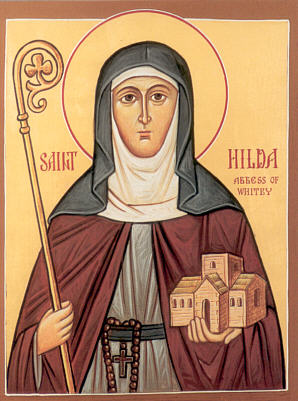Abbess of Whitby (†680)

| Orthodox Outlet for Dogmatic Enquiries | Biographies |
|---|
|
The Venerable Hilda,
Abbess of Whitby (†680)
|
 |
A first approach to the indigenous Orthodox Saints and Martyrs of the Ancient Church who lived and who propagated the Faith in the British Isles and Ireland during the first millennium of Christianity and prior to the Great Schism is being attempted in our website in our desire to inform our readers, who may not be aware of the history, the labours or the martyrdom of this host of Orthodox Saints of the original One, Holy, Catholic and Apostolic Church of our Lord.
"The Church in The British Isles will only begin to grow when she begins to venerate her own Saints" (Saint Arsenios of Paros †1877)
|
SAINT HILDA (614-680) was abbess of the great Whitby Abbey in northern England in the seventh century. She was the daughter of Hereric, the nephew of King Edwin of Northumbria, and like her great-uncle became a Christian through the preaching of St. Paulinus of York, about the year 627, when she was thirteen years old. Moved by the example of her sister Hereswith, who had become a nun at Chelles in Gaul, Hilda journeyed to East Anglia, intending to follow her sister abroad. But St. Aidan recalled her to her own country, and after leading a monastic life for a while on the north bank of the Wear and afterwards at Hartlepool, where she ruled a double monastery of monks and nuns with great success, Hilda eventually undertook to set in order a monastery at Streaneshalch, a place to which the Danes a century or two later gave the name of Whitby. Under the rule of St. Hilda the monastery at Whitby became very famous. The Holy Scriptures were specially studied there, and no less than five of the monastics became bishops, among them St. John, Bishop of Hexham, and St. Wilfrid, Bishop of York. In Whitby, in 664, was held the famous synod which confirmed, among other issues, the manner of calculating the date of Pascha. The fame of St. Hilda's wisdom was so great that from far and near monks and even royal personages came to consult her. Seven years before her death the saint was stricken down with a grievous fever which never left her till she breathed her last, but, in spite of this, she neglected none of her duties to God or to her spiritual children. She passed away most peacefully after receiving the Holy Mysteries of Christ, and the tolling of the monastery bell was heard miraculously at Hackness thirteen miles away, where also a devout nun named Begu saw the soul of St. Hilda borne to heaven by angels. The life of St Hilda is recorded by Bede in his History of the English Church and People. The veneration of St. Hilda from an early period is attested by the inclusion of her name in the calendar of St. Willibrord, written at the beginning of the eighth century. According to one tradition, her relics were translated to Glastonbury by King Edmund, Another tradition holds that St. Edmund brought her relics to Gloucester. Her feast is kept on the seventeenth day of November.
|
Article published in English on: 7-8-2009.
Last update: 7-8-2009.